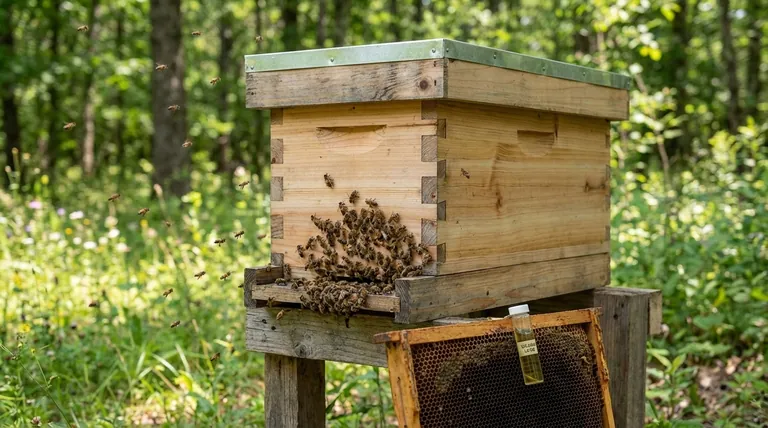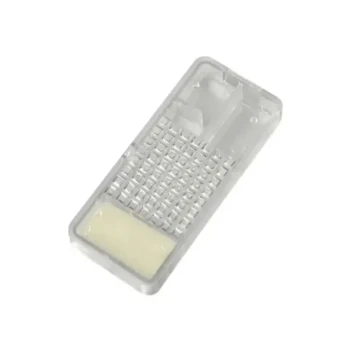Yes, a nucleus (nuc) box is an excellent tool for catching honeybee swarms. A standard 5-frame nuc box provides an ideal cavity size that scout bees find highly attractive when searching for a new home. Its structure allows for a simple and direct transfer of the captured swarm into permanent equipment once they are established.
The core reason a nuc box works so well as a swarm trap is that it perfectly mimics the size and type of cavity that a natural honeybee swarm is instinctively seeking. It's not just a container; it's a purpose-built "starter home" that meets all their requirements.

Why Nuc Boxes are a Natural Fit for Swarms
A swarm of bees is a vulnerable, homeless colony in search of a very specific type of real estate. A nuc box, by its very design, checks all the boxes on a scout bee's list.
The Appeal of the "Perfect" Size
A swarm's primary concern is finding a space that is large enough for the queen to lay and for initial honey storage, but small enough to defend and keep warm.
A standard nuc box provides this ideal volume. A massive, empty deep hive box can feel too large and difficult for a new swarm to thermoregulate, making the smaller, cozier nuc a more appealing choice.
Familiar Internal Structure
Nuc boxes are designed to hold standard frames. By placing a frame with old, dark brood comb inside, you provide a powerful signal to scout bees.
The scent of old wax and propolis communicates that the location has successfully housed bees before, making it a proven and desirable homesite.
Built-in Environmental Control
The smaller internal volume of a nuc box allows a new swarm to more easily control its environment.
Bees can maintain the critical temperature and humidity required for raising brood with far less effort than in a full-sized hive, reducing stress on the new colony.
Choosing the Right Nuc Box for the Job
While the principle is the same, not all nuc boxes are created equal. The material and design can influence your success and how you manage the captured swarm.
Material Matters: Wood, Plastic, or Cardboard
- Wooden nucs are the most durable and offer the best insulation, closely mimicking a natural tree cavity. They are reusable for many seasons.
- Plastic nucs are lightweight, durable, and often include features like ventilation and built-in feeders. They are easy to clean but offer less insulation than wood.
- Waxed cardboard nucs are the most inexpensive option, making them ideal for setting up a large number of swarm traps. They are less durable and typically last only a season or two.
The 5-Frame Standard
While nucs come in various sizes (from 2 to 7 frames), the 5-frame nuc is the most common and versatile option for swarm catching.
This size provides ample space for a typical swarm to get started and uses standard frames, which makes transferring the colony into a 10-frame hive body incredibly simple.
Understanding the Trade-offs
Using a nuc box as a swarm trap is highly effective, but it's important to understand its primary limitation.
The Goal is Temporary Housing
A nuc box is a starter home, not a permanent residence. A healthy swarm will quickly outgrow the 5-frame box.
You must have a plan to move the bees and their frames into a full-sized hive body within a few weeks of capture. Failure to do so can lead to the colony becoming honey-bound and swarming again.
Cost vs. Functionality
A durable wooden nuc box is an investment compared to a simple cardboard box or other DIY swarm traps.
However, its primary function as a tool for raising nucleus colonies and its high effectiveness as a trap often justify the cost for a serious beekeeper.
Making the Right Choice for Your Goal
Your strategy for catching swarms should guide your choice of equipment.
- If your primary focus is maximum attraction and long-term reusability: Choose a wooden 5-frame nuc box baited with a frame of old comb and a swarm lure.
- If your primary focus is setting many inexpensive traps over a large area: Use waxed cardboard nucs, as they are cost-effective to deploy in large numbers.
- If your primary focus is ease of transport and handling: A lightweight plastic nuc can be an excellent, weather-resistant choice that is easy to move once a swarm has moved in.
Ultimately, using a nuc box transforms swarm catching from a game of chance into a calculated and highly effective method of expanding your apiary.
Summary Table:
| Feature | Why It's Ideal for Swarm Catching |
|---|---|
| Perfect Size | Mimics a natural cavity; easy for a new swarm to defend and thermoregulate. |
| Standard Frames | Allows for simple, direct transfer of the colony to a permanent hive. |
| Material Options | Wood (best insulation), Plastic (durable/light), Cardboard (cost-effective for multiple traps). |
| Built-in Appeal | Baiting with an old frame provides the scent of a proven, successful homesite. |
Ready to expand your apiary with effective swarm-catching equipment?
At HONESTBEE, we supply commercial apiaries and beekeeping equipment distributors with high-quality, durable nuc boxes and other essential beekeeping supplies. Our wholesale-focused operations ensure you get the reliable tools you need to successfully attract and establish new colonies.
Contact our team today to discuss your apiary's needs and explore our wholesale product catalog.
Visual Guide

Related Products
- 5 Frame Wooden Nuc Box for Beekeeping
- HONESTBEE Collapsible Tiered Bee Swarm Catcher for Beekeeping
- 5 Frame Langstroth Poly Nuc Corrugated Plastic Nuc Boxes
- Twin Queen Styrofoam Honey Bee Nucs Mating and Breeding Box
- Automatic Heat Preservation 6 Frame Pro Nuc Box for Honey Bee Queen Mating
People Also Ask
- What is a common feature of many 5-frame nuc boxes? The Integrated Feeder for Efficient Colony Growth
- What are the benefits of starting a new bee colony in a nuc box? Boost Colony Success with Efficient Beekeeping
- How many frames does a typical wooden nuc box hold? A Guide to Choosing the Right Size
- What is the purpose of having a nuc in beekeeping? Build a Resilient & Productive Apiary
- What are the benefits of moving nuclei around the apiary? Master Strategic Hive Management



















